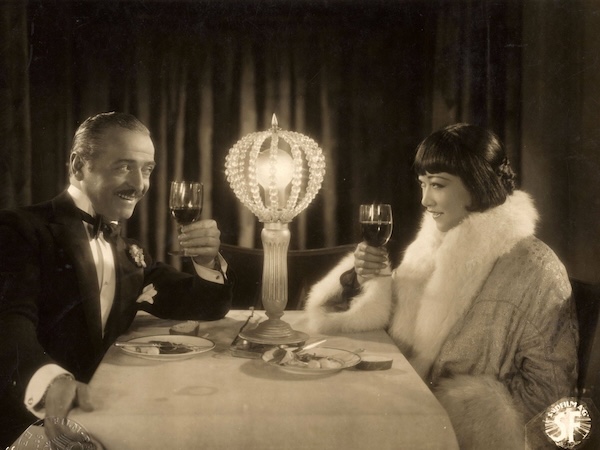GROßSTADTSCHMETTERLING: BALLADE EINER LIEBE (Fior d’ombra; Pavement Butterfly) (DE/GB 1929)
Directed by Richard Eichberg
Großstadtschmetterling: Ballade eine Liebe was Anna May Wong’s second European star vehicle directed by Richard Eichberg, who was on loan from Südfilm to co-produce with British International Pictures. Like Song, her previous feature with Eichberg, Großstadtschmetterling mobilized Wong’s exotic Chinese and modern American personae as well as multi-lingual intertitles and cosmopolitan visual appeals to promote the “Film Europe” project.
Adolf Lantz’s script was freely adapted from a “filmnovella” by Hans Kyser, though shortly after the film’s Berlin premiere Kyser sued Eichberg-Film (Kinematograph, 15.04.1929), demanding his name be removed from the credits, presumably due to disagreements with Lantz’s alterations – too late for the posters, which still bore the author’s name. Filming lasted from December 1928 to February 1929, with studio shooting in Neubabelsberg and location work in Monte Carlo, Nice (for the Carnival scenes), Menton, and Paris. As with Song, this was a German-British co-production, but this time the German and British versions have markedly different endings and the English-language release appears to have been censored: “This film has obviously been considerably cut, and suffers in continuity as a result.” (Kinematograph Weekly, 12.12.1929)
Großstadtschmetterling opens on Bastille Day in Paris. Wong plays the dancer Mah, billed as “the world famous Princess Butterfly” from New York, who is framed by vengeful ex-suitor Coco for the death of Chinese performer Mr. Wu in a stunt show. She escapes, falls into a delirium (visualized through a montage of vortex images), frantically seeks refuge by ascending flights of stairs (economically captured in one long crane shot), and finally ends up outside the door of impoverished Russian painter Kusmin. The artist is captivated, painting her life-size portrait, which he sells to Baron de Neuve. Kusmin asks her to cash the check, but Coco robs her, leading Kusmin to assume she’s the thief. Jilted, Mah turns to the baron, who refashions her in furred gowns and helps clear her name. Kusmin, now coupled with Ellis, the daughter of a wealthy American art dealer, invites Mah to stay, leading to an extreme close-up of Mah slowly tearing up, looking aside, then looking at Kusmin off-screen. In the German version she rejects his offer with the line “Ich gehöre nicht zu euch” (“I do not belong to you”), omitting the second line in the script, “I want to return home.” In the English version the lines are: “I don’t belong to your world. I belong to the pavements.” Both versions end with a poignant long-shot of Mah striding away in her sequin-trimmed evening gown, alone, into the darkness.
Großstadtschmetterling and Song share a similar “Madame Butterfly” narrative, punctuated by cabaret comedy. Großstadtschmetterling has a more charged atmosphere, where lively carnival scenes are contrasted with fog-shrouded desolate night streets, further underscoring the disparity between the white man’s joy and Mah’s sorrow. While the film received criticism for the contrived and clichéd plot – one reviewer even decried its racism (Sozialistische Bildung [Berlin], no. 5, May 1929) – Wong’s presence and performance were universally praised across the European press.
Even in reprising the “Madame Butterfly” type, Mah commands subjective montage shots, including the vortex shots in delirium and the superimpositions in “melancholy,” and when she resorts to gambling. Furthermore, Wong’s character survives this time, despite screenwriter Adolf Lantz’s decision to “Play according to the rules of the industry,” as Cynthia Walk has noted (“Anna May Wong and Weimar Cinema: Orientalism in Postcolonial Germany,” in Beyond Alterity: German Encounters with Modern East Asia, 2014). A traditional happy ending would have involved Mah marrying a white man, yet that would have violated American anti-miscegenation laws and cost the film a valuable market (though it appears it was never released in the U.S.). Killing her off was what was expected, as Lantz himself wrote in “Filmstar muß sterben” [“Movie Star must die”] (Tempo, 04.10.1929). One has to wonder whether her walking away, alive, as she does here, might be the “happy” ending after all. Yes, she was excluded from the narrative, but she gained the power to exit from heteronormative coupling altogether.
Following Song (1928) and Piccadilly (1929), Großstadtschmetterling was Wong’s last silent film. In late 1929, she learned German and French to make her first talkie, shot in three languages: Hai Tang (German), The Flame of Love (English), and L’Amour maître des choses (French), with the German and English versions directed by Eichberg, and the French by Jean Kemm. Yet another “Film Europe” project, these three films star Wong working with three different casts, speaking three languages. With this successful transition to talkies and her newly minted multi-lingual ethno-cosmopolitanism, Wong sailed back to the U.S. in October 1930, to star in the Broadway production of the play On the Spot by Edgar Wallace, and to jump-start the second phase of her Hollywood career.
Yiman Wang

GROßSTADTSCHMETTERLING: BALLADE EINER LIEBE (Fior d’ombra; Pavement Butterfly) (DE/GB, 1929)
Titoli di lavorazione/Working titles: Die Fremde; Asphalt Schmetterling.
regia/dir: Richard Eichberg.
scen: Adolf Lantz, dalla “filmnovella” di/from the “filmnovella” by Hans Kyser.
photog: Heinrich Gärtner, Otto Baecker.
scg/des: W. A. Hermmann, W. Schlichting.
mus: Max Pflugmacher (Universum, Berlin), Hansheinrich Dransmann (Titania-Palast, Berlin).
cast: Anna May Wong (Mah), Tilla Garden (Ellis Working), Fred Louis Lerch (Fedja Kusmin), Alexander Granach (Coco), Gaston Jacquet (Baron de Neuve), E. F. Bostwick (Mr. Working, an American art dealer), Szöke Szakáll (Paul Bonnet), Nien Sön Ling (Mr. Wu), [John Höxter].
prod: Eichberg-Film GmbH (Berlin) / British International Pictures Ltd. (B.I.P.) (London).
dist: Südfilm A.G. (DE); Wardour (GB).
première: 10.04.1929 (Universum, Berlin; Titania-Palast, Berlin); 07.12.1929 (Regal, London).
copia/copy: DCP, 96’33” (da/from 35mm neg. nitr., 7989 ft. [orig. l: 2452 m. (DE), 7989 ft. (GB)], 24 fps); did./titles: GER.
fonte/source: DFF – Deutsches Filminstitut & Filmmuseum, Frankfurt.


 Italiano
Italiano